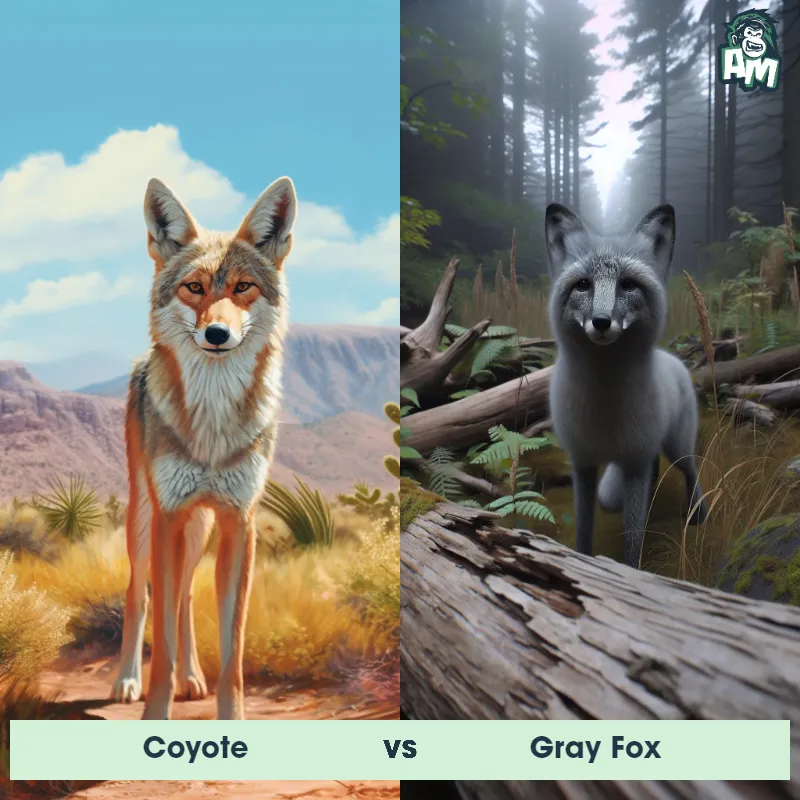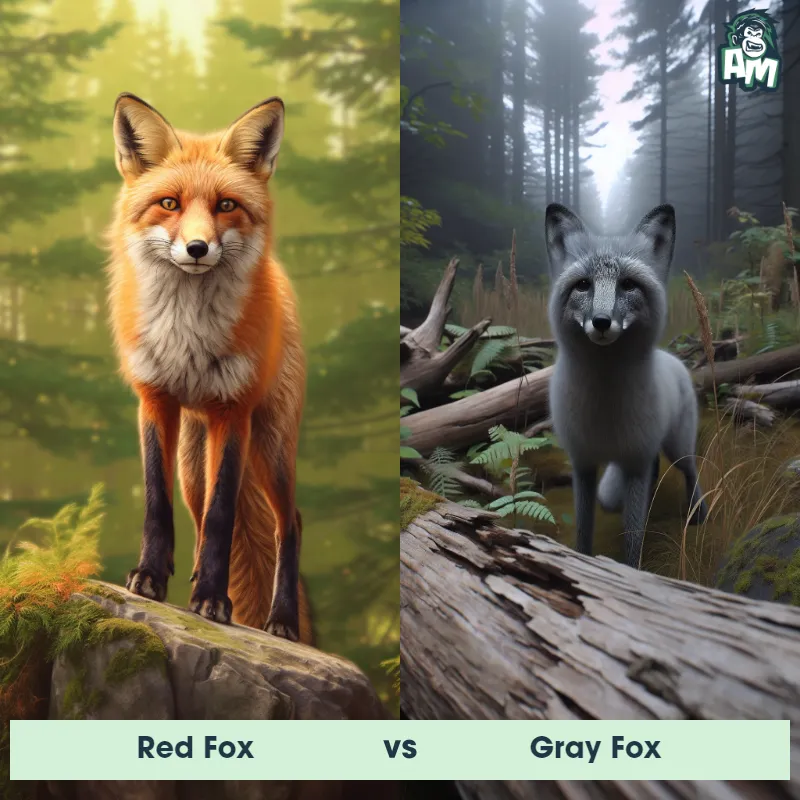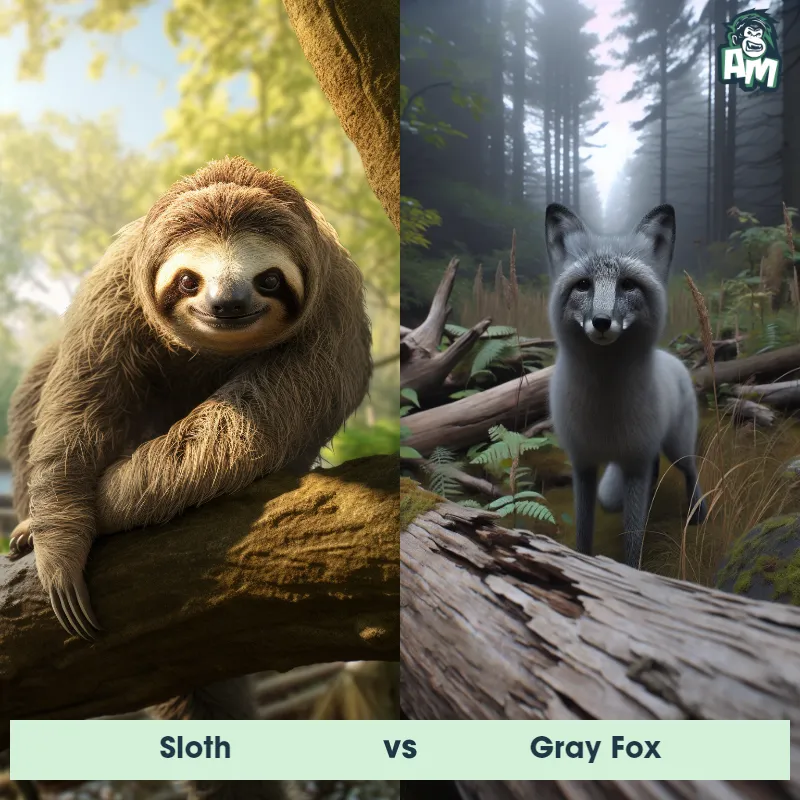The Gray Fox
The Gray Fox, scientifically known as Urocyon cinereoargenteus, is a small to medium-sized canid native to North and South America. They are recognized by their unique coat, which is a mix of gray, brown, and reddish colors. The distinguishing feature of this species is their black-tipped bushy tail, which they can use to climb trees, making them the only member of the canid family capable of this feat. With a body length ranging from 76 to 112 cm and weighing between 4.5 to 7 kg, they possess sharp, curved claws and a slender build, allowing them to maneuver through densely vegetated areas with ease. Gray Foxes are known for their agility, quick movements, and exceptional camouflage, making them highly adaptable predators.

| Gray Fox | |
|---|---|
| Size | 2-3 feet (61-91 centimeters) in height, 3.5-4 feet (107-122 centimeters) in length |
| Weight | 7-13 pounds (3.2-5.9 kilograms) |
| Speed | 42 mph (68 km/h) |
| Key Strength | Agility and climbing ability |
| Biggest Weakness | Size and strength compared to larger predators |
| Scientific Name | Urocyon cinereoargenteus |
| Family | Canidae |
| Habitat | Forests, mountains, urban areas |
| Geography | North America |
| Diet | Omnivorous - fruits, berries, insects, small mammals, birds, reptiles, carrion |
| Lifespan | 15 years - 20 years |

The Gray Fox
The Gray Fox, scientifically known as Urocyon cinereoargenteus, is a small to medium-sized canid native to North and South America. They are recognized by their unique coat, which is a mix of gray, brown, and reddish colors. The distinguishing feature of this species is their black-tipped bushy tail, which they can use to climb trees, making them the only member of the canid family capable of this feat. With a body length ranging from 76 to 112 cm and weighing between 4.5 to 7 kg, they possess sharp, curved claws and a slender build, allowing them to maneuver through densely vegetated areas with ease. Gray Foxes are known for their agility, quick movements, and exceptional camouflage, making them highly adaptable predators.
Fun Fact: Gray Foxes are one of the few canids that are known to climb trees, due to their flexible wrists and strong claws that enable them to scale heights of over 6 meters.
| Gray Fox | |
|---|---|
| Size | 2-3 feet (61-91 centimeters) in height, 3.5-4 feet (107-122 centimeters) in length |
| Weight | 7-13 pounds (3.2-5.9 kilograms) |
| Speed | 42 mph (68 km/h) |
| Key Strength | Agility and climbing ability |
| Biggest Weakness | Size and strength compared to larger predators |
| Scientific Name | Urocyon cinereoargenteus |
| Family | Canidae |
| Habitat | Forests, mountains, urban areas |
| Geography | North America |
| Diet | Omnivorous - fruits, berries, insects, small mammals, birds, reptiles, carrion |
| Lifespan | 15 years - 20 years |
Gray Fox Matchups
We use AI to simulate matchups between the Gray Fox and other animals. Our simulation considers size, strength, and natural predatory behaviors to determine the most likely outcome.

Can't find the Matchup you want?
Create Your Own MatchupGray Fox: Diet, Predators, Aggression, and Defensive Behaviors
What do Gray Foxes eat?
Gray Foxes have a varied diet that includes small mammals, birds, insects, fruits, and plants. They are opportunistic feeders, meaning they will eat what is readily available in their environment. They are skilled hunters and have been known to climb trees to catch prey such as squirrels or birds.
Do Gray Foxes have any predators?
Gray Foxes have a few natural predators, including coyotes, bobcats, and birds of prey such as eagles and owls. Humans also pose a threat to Gray Fox populations through hunting and habitat destruction.
Are Gray Foxes aggressive?
Gray Foxes are generally shy and elusive animals, but they can become aggressive if they feel threatened or cornered. They are solitary animals and will usually avoid conflict with other animals.
Do Gray Foxes fight?
While Gray Foxes may fight to establish dominance or defend their territory, they are more likely to use avoidance and evasion tactics to avoid confrontation. They are known to be highly adaptable and will choose flight over fight when possible.
How do Gray Foxes defend themselves?
Gray Foxes have several ways to defend themselves from predators, including their keen senses of sight, smell, and hearing. They are agile climbers and can escape danger by climbing trees. They also have sharp teeth and claws that they can use to defend themselves in close combat.
What is the biggest weakness of Gray Foxes in a fight?
One weakness of Gray Foxes in a fight is their relatively small size compared to some of their predators, such as coyotes or bobcats. While they are agile and quick, their small stature can put them at a disadvantage in a physical confrontation. Additionally, their preference for avoiding conflict means they may not have developed strong fighting skills.
Fun Fact: Unlike other fox species, Gray Foxes are unique in their ability to retract their claws, which is a characteristic typically associated with felids cats.
Fun Fact: Gray Foxes have a remarkably varied diet, consisting of small mammals, birds, reptiles, insects, fruits, and even carrion, showcasing their opportunistic and adaptable nature.













